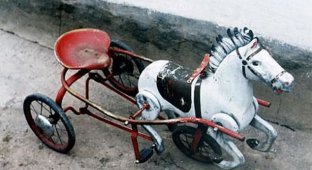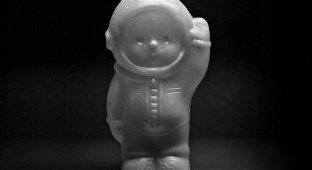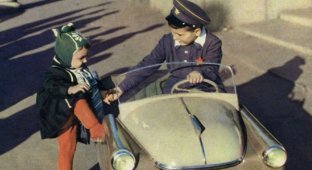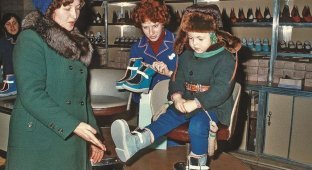History of the kaleidoscope (15 photos)
Remember this toy? Every Soviet child had one. I wonder if anyone still has one of these? I suggest you plunge into the history of this amazing item.

Kaleidoscope. A kaleidoscope of events, a kaleidoscope of history, events spinning like in a kaleidoscope... Such familiar clichés. But in childhood, when hearing the word kaleidoscope, only one simple association arose - a toy. In general, children's toys very often hide a long, interesting history behind them; sometimes toys become a lifelong passion. Adults often learn their hobbies from children. So, by the way, it happened with stamps - postage stamps were first collected by children and played with them like candy wrappers, exchanged, and showed off. Nowadays, it is not only children who seriously collect stamps; they hunt for stamps, they save money for them for many years, someone is ready to give everything for some especially valuable specimen, sometimes a stamp costs the collector his life. But let's not stray too far from the subject of our conversation today. Let's return to the kaleidoscope.

This bright and seemingly simple, but fascinating children's toy was invented in 1816 by the Scottish physicist Sir David Brewster. Brewster has been interested in the properties of glass and light since childhood. At the age of 10 he built his first telescope. Then there were years of studying at the University of Edinburgh (by the way, Brewster was a child prodigy, he became a student at the age of 12), studying optics and physics of light, and many scientific discoveries. It is interesting that Brewster, a truly multifaceted man, almost became a preacher: only natural modesty prevented him.
Coming to the pulpit for the first time, Brewster literally lost his voice and never dared to preach sermons. Contemporaries wrote that that day was a grief for the Church and happiness for science. Science has indeed acquired a genius. However, Brewster - the inventor of the lenticular stereoscope, polygonal mirrors, polarimeter and designer of lenses for lighthouses - ironically gained fame through a seemingly simple children's toy. The kaleidoscope brought Brewster the glory of a discoverer, but did not bring a penny of money. The patent was filed somehow too slowly, and enterprising businessmen quickly mastered the technology and toys, simple in their execution, appeared in all stores.

Brewster’s invention “colored” life - representatives of all classes and estates, regardless of age, joyfully watched the bizarre patterns that were never repeated. To be fair, I will say that Brewster was a man whom fortune loved - he lived in a happy marriage for forty years, was the father of four sons and two daughters. By the way, the youngest daughter was born from his second wife (the first died when Brewster was 66 years old). The crazy happy genius remarried at the age of 75. Let's digress for a second and add some patriotism to the story. They say that before Brewster, kaleidoscopes were invented in Russia. And none other than Lomonosov did this, but it never occurred to Mikhailo Vasilyevich to patent the “trifle.”
David Buster's Kaleidoscope brought glory to its author, but that's all. The patent was issued too late, and during this time many enterprising businessmen managed not only to appreciate the invention, but also to intercept this new amazing idea. Soon these simple-to-make, but at that time, completely original toys appeared in stores all over the country. With splashes of colored shards of glass, repeatedly reflected by mirrors, the kaleidoscope burst into the monotonous life of all ordinary people of that time, regardless of age, class and social status. Giving a kaleidoscope as a gift has become a good Scottish tradition.
When the news of this wonderful European invention reached America, it was already 1870. The American scientist Charles Bush, who received one of the kaleidoscopes brought from Europe, became extremely interested in the new “toy.” Over the years, he created and modernized kaleidoscopes, tried to change their shape, the tilt of the mirrors, and the contents. It was Charles Bush who created the first “cabinet kaleidoscope” - a tube made of black thick cardboard, with a bronze rotating ring at the end, movably mounted on a beautiful wooden stand.

A kaleidoscope is not just a toy. The more I learned about it, the more I realized that kaleidoscope is a philosophy. Yes Yes exactly. Do you know what a kaleidoscope is always compared to, and entire scientific works are devoted to comparison? With a mandala. There is even a legend that the Egyptians first created something like a kaleidoscope during their meditations, using carefully polished shards of limestone. Therefore, collectors and artists, especially devoted to their passion, love to endow kaleidoscopes with some kind of magical power to influence people. They say that the kaleidoscope inspires the mind and awakens the heart.
There are even whole directions of meditation with a kaleidoscope, people meditate while looking at patterns, there is even a special designation - meditoscope. The meditoscope even received its own development, becoming a chacroscope. The chacroscope was invented and created by Meryl Ann Butler, an artist interested in the theory of color and its effect on the human body. The traditional colors used in kaleidoscopes correspond to specific areas in the chakras and the human body. Meryl Butler added four more colors, which are traditionally responsible for the feminine (silver), masculine (gold), rebirth (fuchsia) and love (pink). Exercises with a chacroscope, according to Butler, allow a person to open their “inner vision.”

Kaleidoscopes are also used in medicine. Dr. Clifford Kuhn, head of the Department of Psychiatry and Behavioral Sciences at the University of Kentucky, began by collecting kaleidoscopes and then introduced them into his practice of treating patients. Looking at patterns in a kaleidoscope calms your nerves, relieves tension and stress. Now in America and Europe this method of treatment is no longer exotic.

Kaleidoscopes are used by musicians and composers when tuning into a game or catching a new melody that appears in their thoughts. It is believed that each color corresponds to a musical note: observing patterns in a kaleidoscope, you see music.
The kaleidoscope has many fans: children who look at patterns for fun, and artists who create the most complex and beautiful patterns, calculate incredible compositions, select materials, engineers, collectors, doctors and philosophers. Abroad, kaleidoscopes became so popular that in 1986, Cozy Baker created a special society that united all collectors and professionals, artists and theorists, manufacturers and buyers - the Brewster Kaleidoscope Society.


It is perhaps impossible to cover everything that society does; it is its own separate, huge world - the world of people who are lost in the play of colors and shapes. Speaking of shapes, there are several types of kaleidoscopes. Actually a classic kaleidoscope: a system of mirrors in which multi-colored pieces of glass are reflected. Teleidoscope - instead of shimmering tinsel, the teleidoscope has a regular lens, and the mosaic consists of objects from the surrounding world. A hybrid of a kaleidoscope and a teleidoscope - the picture consists of both glass and objects from the surrounding world. A parascope through which you can observe a three-dimensional image. And an oil kaleidoscope, where instead of pieces of glass there is a tube filled with an oily liquid with various crystals.


Perhaps most often, we are familiar with a kaleidoscope, which is a plastic or metal tube with a rim at the end, but in fact there are many forms and types of kaleidoscopes, some of them are real works of art. But the world's largest kaleidoscope was built in Japan in 2005 during the EXPO exhibition. The Earth Tower was built in the Nagoya pavilion. Water flowed down the walls of this triangular tower, 47 meters high, from top to bottom, forming different patterns, depending on the direction of the sun's rays. At the junctions of the tower walls, jets of air came out, simulating wind. The pavilion heard melodious sounds that came from three windmills installed next to the tower. Inside the tower was the world's largest kaleidoscope.



The classic kaleidoscope has a large number of models. They arose in the century before last. Afaneidoscope, debuscope and typoscope - this is just a small list of names of the siblings of the kaleidoscope. Despite the apparent simplicity of the toy, many inventors are still improving it, adding something of their own to the simple design. Our compatriots have also patented a number of inventions in the field of creating kaleidoscopes. . Abroad, the production of kaleidoscopes has become an independent art form. In 1986, the Brewster Kaleidoscope Society was founded. There is no similar organization in Russia yet.
 The kaleidoscope in V. Dahl’s “Explanatory Dictionary” is very poetically named: “A pattern is a tube with two mirrors a wedge, where colored glass is reflected by a patterned star, variable, with every movement or revolution of the tube"
The kaleidoscope in V. Dahl’s “Explanatory Dictionary” is very poetically named: “A pattern is a tube with two mirrors a wedge, where colored glass is reflected by a patterned star, variable, with every movement or revolution of the tube"
How is a kaleidoscope made? What is it inside that allows you to see so many patterns that never repeat? These are just some of the questions that arise as soon as you get your hands on a kaleidoscope. Let's lift the veil of secrecy over the structure of this toy.
 Kaleidoscope is a source of inspiration. When you see endlessly folding patterns, you understand that the world is limitless, just like human imagination is limitless.
Kaleidoscope is a source of inspiration. When you see endlessly folding patterns, you understand that the world is limitless, just like human imagination is limitless.
A kaleidoscope is a positive field generator. It is able to create a mood, disperse melancholy, and improve well-being. 15 minutes of looking at kaleidoscope pictures is comparable to 5 minutes of healthy laughter.
Kaleidoscope is a home therapist. It helps relieve optic nerve fatigue, which is especially important in the modern world of computers and electronics. It also improves tone during illness and speeds up the healing process.
People who take it in their hands do not part with it. 25 pattern-forming elements do not repeat for 500 million years.


























